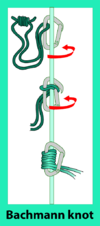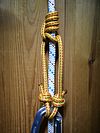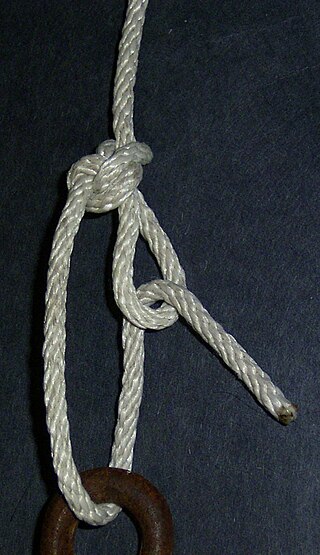
The trucker's hitch is a compound knot commonly used for securing loads on trucks or trailers. The general arrangement, using loops and turns in the rope itself to form a crude block and tackle, has long been used to tension lines and is known by multiple names. Knot author Geoffrey Budworth claims the knot can be traced back to the days when carters and hawkers used horse-drawn conveyances to move their wares from place to place.

The taut-line hitch is an adjustable loop knot for use on lines under tension. It is useful when the length of a line will need to be periodically adjusted in order to maintain tension. It is made by tying a rolling hitch around the standing part after passing around an anchor object. Tension is maintained by sliding the hitch to adjust the size of the loop, thus changing the effective length of the standing part without retying the knot.

The sailor's hitch is a secure, jam-proof hitch knot. A hitch knot is a type of knot that has the ability to fit to the size and shape of an object that it is being tied to.
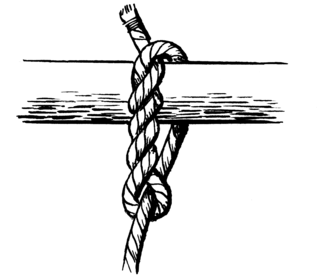
The timber hitch is a knot used to attach a single length of rope to a cylindrical object. Secure while tension is maintained, it is easily untied even after heavy loading.

The klemheist knot or French Machard knot is a type of friction hitch that grips the rope when weight is applied, and is free to move when the weight is released. It is used similarly to a Prusik knot or the Bachmann knot to ascend or descend a climbing rope. One advantage is that webbing can be used as an alternative to cord. The Klemheist is easier to slide up than a Prusik. The klemheist is also a way to attach a snubber to the anchor rope of small boats, with the advantage that it is easy to undo.

Tree climbing is a recreational or functional activity consisting of ascending and moving around in the crowns of trees.

Glossary of climbing terms relates to rock climbing, mountaineering, and to ice climbing.

Abseiling, also known as rappelling, is the controlled descent of a steep slope, such as a rock face, by moving down a rope. When abseiling, the person descending controls their own movement down the rope, in contrast to lowering off, in which the rope attached to the person descending is paid out by their belayer.

The sheet bend is a bend knot. It is practical for joining lines of different diameter or rigidity.

An icicle hitch is a knot that is used for connecting to a post when weight is applied to an end running parallel to the post in a specific direction. This type of hitch will hold its place even when holding a substantial load on a smooth surface. One can even suspend from a tapered post with this knot.

The Munter hitch, also known as the Italian hitch, mezzo barcaiolo or the crossing hitch, is a simple adjustable knot, commonly used by climbers, cavers, and rescuers to control friction in a life-lining or belay system. To climbers, this hitch is also known as HMS, the abbreviation for the German term Halbmastwurfsicherung, meaning half clove hitch belay. This technique can be used with a special "pear-shaped" HMS locking carabiner, or any locking carabiner wide enough to take two turns of the rope.

The Blake's hitch is a friction hitch commonly used by arborists and tree climbers as an ascending knot. Unlike other common climbing hitches, which often use a loop of cord, the Blake's hitch is formed using the end of a rope. Although it is a stable knot, it is often backed up with a stopper knot, such as a figure-of-eight knot, for safety. It is used for both ascending and descending, and is preferred by many arborists over other hitches, such as the taut-line hitch, as it is less prone to binding.

A Prusik is a friction hitch or knot used to attach a loop of cord around a rope, applied in climbing, canyoneering, mountaineering, caving, rope rescue, ziplining, and by arborists. The term Prusik is a name for both the loops of cord used to tie the hitch and the hitch itself, and the verb is "to prusik". More casually, the term is used for any friction hitch or device that can grab a rope. Due to the pronunciation, the word is often misspelled Prussik, Prussick, or Prussic.

The International Guild of Knot Tyers is a worldwide association for people with an interest in knots and knot tying.

An autoblock is a rope device used in climbing and caving for both rappelling (downward) and ascending (upward).

A Z-Drag or Z-Rig is an arrangement of lines and pulleys, effectively forming a block and tackle, that is commonly used in rescue situations. The basic arrangement results in pulling the hauling end 3 times the distance the load is moved, providing a theoretical mechanical advantage of three to one. In actual practice the advantage will be reduced by friction in the pulleys or carabiners. The advantage will also be reduced if the pull on the hauling end is not parallel to the direction the load moves in. The name comes from the fact that the arrangement of lines is roughly Z shaped. Besides the mechanical advantage to pulling, it also uses only part of the total length of the rope for the block and tackle arrangement.
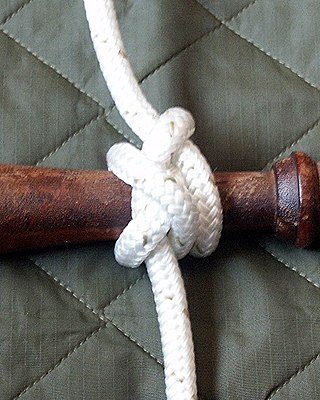
The snuggle hitch is a modification of the clove hitch, and is stronger and more secure. Owen K. Nuttall of the International Guild of Knot Tyers came up with this unique hitch, and it was first documented in the Guild's Knotting Matters magazine issue of January, 1987. Generally, hitches are used to attach a line to another rope or spar, pole, etc., and are usually temporary. Thus, they should be relatively easy to untie.
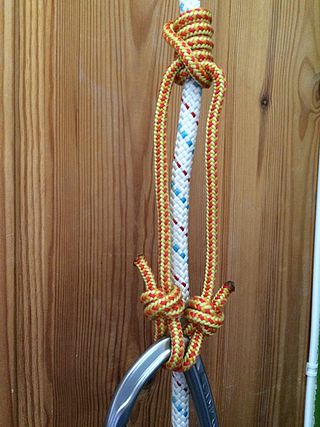
Distel hitch is a friction hitch knot used to attach a carabiner to a rope, allowing a climber to descend or ascend. The knot is similar to the prusik knot, however it grips the rope more consistently, making for increased climber control.


